Archive for October, 2023
What You Need To Know About Cold Storage Applications
Operating a forklift in a cold storage environment has unique challenges and safety considerations. This blog post will address common questions about forklift operations in cold storage applications to ensure safety, efficiency, and productivity in these demanding conditions.
1. What are the main challenges of operating a forklift in a cold storage environment?
Cold storage environments present challenges like reduced battery performance, slippery surfaces, and decreased visibility due to condensation or frost on the forklift and racking. Forklift operators must also contend with the risk of hypothermia and frostbite.
2. How are forklift batteries affected by cold temperatures, and what can you do to mitigate this?
Cold temperatures can reduce the efficiency and capacity of forklift batteries. It’s essential to keep batteries warm when not in use, use battery blankets or heated storage, and ensure proper charging procedures. Additionally, consider using lithium-ion batteries that are less affected by cold temperatures than traditional lead-acid batteries.
3. What safety precautions should forklift operators take in cold storage facilities?
Operators should wear appropriate cold-weather gear, including insulated clothing, gloves, and headgear. Maintain clear visibility by regularly defrosting or clearing condensation from the windshield and ensuring good lighting in the facility. Take frequent breaks to avoid exposure to extreme cold and prioritize safety above all else.
4. What kind of tires work best on forklifts in cold storage applications?
In cold storage applications, it’s advisable to use non-marking tires designed for indoor use. As the name suggests, these tires are less likely to leave marks on the floor and provide better traction on icy or wet surfaces.
5. Are there specific forklift options or modifications for cold storage use?
Yes, options and modifications like heated cabins, additional lighting, and non-slip mats can improve safety and efficiency in these challenging conditions. Make sure any options or modifications are compliant with safety regulations.
6. How should forklift operators adjust their driving techniques in cold storage facilities?
Operators should drive more slowly and cautiously in cold storage environments due to reduced traction. Be mindful of potential ice patches and use gentle, controlled movements. Avoid abrupt starts and stops to prevent accidents.
7. How can forklift maintenance be adapted for cold storage conditions?
Regular forklift maintenance is crucial. Ensure the forklift’s heating system, defrosters, and lighting are in top condition. Use lubricants and fluids rated for cold temperatures and implement a preventive maintenance schedule to address cold-related wear and tear.
8. What role does proper training play in forklift operation within a cold storage facility?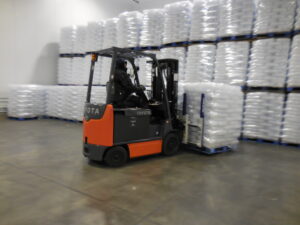
Proper training is paramount. Forklift operators should receive specialized training that covers the unique challenges of cold storage environments, including the impact of cold temperatures on equipment and safety procedures specific to these conditions.
Forklift operators in Los Angeles County can sign up for forklift certification training in Santa Fe Springs on the first and third Friday of every month.
9. Are there regulations or standards for forklift operation in cold storage facilities?
While there are no specific regulations solely for cold storage, general forklift safety regulations apply. Additionally, it’s essential to adhere to regulations related to cold storage safety, such as maintaining emergency exits and fire suppression systems in proper working order.
10. How can forklift operators stay alert and focus during long shifts in cold storage environments?
Staying alert is crucial for safety. Operators should take regular breaks in warm areas to prevent cold-related fatigue and implement shift rotations to avoid extended exposure to extreme cold. Hydration and nutrition are also important.
You can maintain a productive and safe work environment in even the coldest conditions by understanding the unique challenges and taking appropriate measures such as battery care, safety precautions, and equipment adjustments. Stay warm and safe out there!
Would you like an expert to help determine which truck and specifications suit your cold storage operation? Contact us to schedule a site visit today.
Ten Ways to Make Your Warehouse Safer
Neglecting proper forklift safety protocols can lead to accidents, injuries, and property damage. Learn ten forklift operator safety tips to maintain a safe and productive work environment.
1. Proper Training and Certification
Forklift safety begins with education and training. Comprehensive forklift operator training covers equipment controls, load handling, inspection, and safety procedures. Training programs typically include classroom instruction, hands-on training, and evaluations. Anyone who operates a forklift must complete forklift operator safety training and have a certification on every different type of forklift they drive.
Toyota Material Handling Solutions provides forklift operator training in Los Angeles County. Find dates and sign up for forklift operator training here.
2. Inspect Your Forklift Before Use
A thorough pre-operational inspection is a fundamental safety practice. Before each shift, take the time to inspect the forklift for any signs of damage, leaks, or malfunctions. This inspection should cover various components, including tires, brakes, steering, lights, and safety features like horns and seatbelts. If you identify any issues during the inspection, no matter how minor they may seem, it is crucial to report them immediately to your supervisor. Regular maintenance and prompt repairs are essential for ensuring the forklift is in good working condition.
OSHA standards require daily pre-shift inspection of powered industrial trucks. You can find sample daily checklists on OSHA’s website here.
3. Wear Appropriate Personal Protective Equipment (PPE)
Personal Protective Equipment (PPE) is vital for forklift operator safety. Always wear the necessary PPE, typically a hard hat to protect your head, a high-visibility vest to enhance your visibility to others, and steel-toed shoes to safeguard your feet from potential hazards. PPE provides an additional layer of protection, reducing the risk of injury in the event of an accident or impact. It’s a simple but effective way to mitigate potential risks while operating a forklift.
4. Stay Aware of Your Surroundings
Constant awareness is a cornerstone of forklift safety. As an operator, you must always remain vigilant about your surroundings. Keep an eye out for pedestrians, other vehicles, and obstacles that might be in your path. Use the forklift’s horn and lights to enhance your visibility and alert others to your presence. Additionally, be particularly cautious in areas with restricted visibility, such as blind corners, and always yield the right of way to pedestrians.
5. Obey Speed Limits and Load Capacity
Every forklift has specific speed limits and load capacities, which the manufacturer sets. It is imperative to strictly adhere to these limits to ensure safety. Exceeding speed limits or carrying loads beyond the recommended capacity can lead to accidents, tip-overs, and loss of control. Forklift operators should observe speed limits in indoor and outdoor settings, where factors like uneven terrain, weather conditions, and varying surfaces can affect the forklift’s stability and maneuverability.
6. Operate Smoothly
Smooth operation is essential for safely handling a forklift. Start and stop the forklift smoothly to prevent sudden jolts that could dislodge the load or compromise stability. Jerky movements can damage the goods and lead to accidents. Avoid making sharp turns, sudden accelerations, or abrupt stops whenever possible. These actions can unbalance the load and make it more challenging to control the forklift.
7. Safe Load Handling
Proper load handling is critical for forklift safety. When picking up a load, it is vital to ensure it is balanced and secure on the forks. This balance minimizes the risk of the load shifting or falling while in transit. The load should be tilted slightly backward when raising it to improve stability. This prevents the load from leaning forward, which could tip the forklift. If your forklift has attachments, ensure they are installed correctly and securely before use. Always be aware of overhead clearance when stacking loads. Coinciding with overhead structures or objects can lead to significant damage and safety hazards.
8. No Horseplay Allowed
While it may seem obvious, it’s worth emphasizing that forklifts are not toys, and horseplay should never happen. Engaging in activities such as racing with other forklifts or carrying passengers endangers your safety and jeopardizes the safety of those around you. Encourage a culture of responsible behavior and clarify that safety is non-negotiable in your workplace. Setting a strong example and promoting a safe work environment will help prevent unnecessary risks and accidents.
9. Use the Parking Brake
When your forklift is unused, engage the parking brake and turn off the engine. This seemingly routine step is crucial for maintaining a safe work environment. The parking brake prevents the forklift from moving unintentionally, particularly when parked on an incline.
10. Report Incidents and Near-Misses
Reporting incidents and near-misses is vital to forklift safety. Whether you’re directly involved in an incident or simply a witness to a near-miss, it’s crucial to report these events to your supervisor immediately. Reporting serves several essential functions. It allows for a thorough investigation to identify root causes and prevent similar incidents in the future. It also helps in implementing corrective actions and improving safety measures to enhance the overall safety culture of your workplace.
It’s important to remember that forklift operators should never compromise safety for expediency or convenience. Your vigilance and commitment to safety play a significant role in preventing accidents and injuries in the workplace. Following these guidelines protects yourself and contributes to a safer, more productive, and accident-free work environment.
Stay safe, and remember: safety first, always.
We provide training in Santa Fe Springs on the 1st and 3rd Friday of every month. Sign up for forklift certification today.
Everything You Need To Know About Electric Forklifts
Electric forklifts offer a sustainable and cost-effective solution for material handling. Understanding their advantages and capabilities is essential for making informed decisions about incorporating them into your business operations. In this blog post, we’ll answer 15 frequently asked questions about electric forklifts to help you better understand their benefits, operation, and more.
1. What are the advantages of electric forklifts over gas or diesel forklifts?
Electric forklifts offer numerous benefits, including lower operating costs, reduced emissions, less maintenance, operator comfort, and a quieter operation.
Switching to electric forklifts also helps California companies get ahead of the California Air Resources Board (CARB) Zero-Emission Mandate. CARB’s new mandate requires all new forklifts leased and sold in California after 2026 to be zero-emission vehicles. Learn more about the upcoming regulations here.
2. Are electric forklifts suitable for outdoor use?
Electric forklifts can operate outdoors but are typically better suited for indoor applications. However, some models work outdoors with features like all-terrain tires and weatherproofing.
Indoor and outdoor electric forklift models include Toyota’s 48V Electric Pneumatic, Toyota’s 80V Electric Pneumatic, Heli’s G Series AC Electric Pneumatic, and Noblelift’s 3-Wheel Electric Forklift.
3. How long does it take to charge an electric forklift? 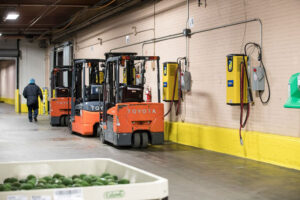
The charging time for electric forklifts depends on the battery capacity and charger type. Standard charging for a battery typically takes 8 to 10 hours, while fast chargers can reduce this to 2 to 4 hours. If you’re running multi-shift cycles, you can minimize downtime with opportunity-charging during lunch, breaks, and shift changes.
4. What is the lifespan of an electric forklift battery?
An electric forklift battery can last 5 to 7 years with proper maintenance. However, the lifespan can vary depending on usage, charging practices, and environmental conditions. Adopting simple forklift battery watering techniques gives you the best chance of preserving its lifecycle and enjoying maximum value from your purchase. Learn answers to frequently asked questions about watering a forklift battery here.
Do you need help with energy solutions or battery maintenance? TMHS recently partnered with Advanced Energy Solutions to give you access to the best energy experts in the industry. Contact AES to set up a free energy consultation today.
5. Can electric forklifts lift heavy loads?
Electric forklifts can lift heavy loads, and their lifting capacity varies depending on the model and configuration. Some electric forklifts are designed for light-duty applications, while others can handle heavy loads of up to 40,000 pounds or more.
6. Are electric forklifts as powerful as gas or diesel forklifts? 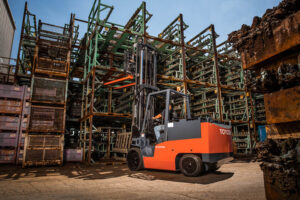
Electric forklifts can be as powerful as gas or diesel, and high-capacity electric forklifts, like Toyota’s High-Capacity Electric Cushion Forklifts are available for heavy-duty applications.
7. Are electric forklifts more expensive to purchase than gas or diesel forklifts?
Electric forklifts have a higher initial purchase price than their internal combustion engine counterparts since you essentially pay for fuel (the battery) upfront. However, they offer long-term cost savings due to lower operating and maintenance expenses.
8. Can electric forklifts operate in cold environments? 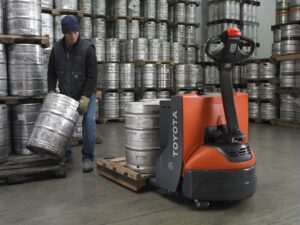
Yes, electric forklifts can operate in cold environments, but extreme cold can affect battery performance. Some electric forklifts are equipped with cold storage packages to address this issue.
9. What are the typical maintenance requirements for electric forklifts?
Regular maintenance for electric forklifts includes checking and maintaining the battery, inspecting tires, brakes, and other components, and ensuring proper charging practices. Maintenance schedules should follow manufacturer recommendations.
10. Are there government incentives for using electric forklifts?
In some regions, government incentives and rebates may be available to encourage the adoption of electric forklifts and other electric vehicles, and to offset the initial purchase cost. You can learn about California’s electric equipment incentives here.
11. Can electric forklifts be customized for specific applications?
Electric forklifts can be customized with various attachments and configurations to suit specific material handling needs. This versatility makes them adaptable to a wide range of industries and tasks.
12. What is regenerative braking in electric forklifts?
Regenerative braking is a feature in many electric forklifts that converts kinetic energy into electrical energy during braking, which returns to the battery. This feature improves energy efficiency and extends the battery’s lifespan.
13. Can electric forklifts be used in food handling or pharmaceutical environments? 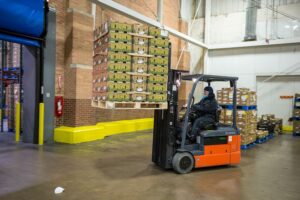
Yes, electric forklifts are suitable for food handling and pharmaceutical environments because they do not emit harmful fumes or exhaust, ensuring the safety and cleanliness of these sensitive areas.
14. Are there different types of electric forklift batteries?
Yes, there are two main types of electric forklift batteries: traditional lead-acid batteries and lithium-ion batteries. Each type has advantages and disadvantages, such as energy density and lifespan.
Do you have questions about forklift batteries? Our energy experts at Advanced Energy Solutions are here to help. Contact AES for a free energy consultation today.
15. Can electric forklifts be equipped with telematics for fleet management?
Most electric forklifts can pair with telematics systems that provide real-time vehicle location, usage, and performance data. This data can help improve fleet management and maintenance.
Electric forklifts have become indispensable tools in modern material handling. Their eco-friendly nature, versatility, and cost-efficiency make them attractive for businesses across various industries. Whether you’re looking to reduce emissions, cut operational costs, enhance the efficiency of your material handling operations or get ahead of CARB’s Zero-Emission Mandate, electric forklifts are a solution worth exploring.
